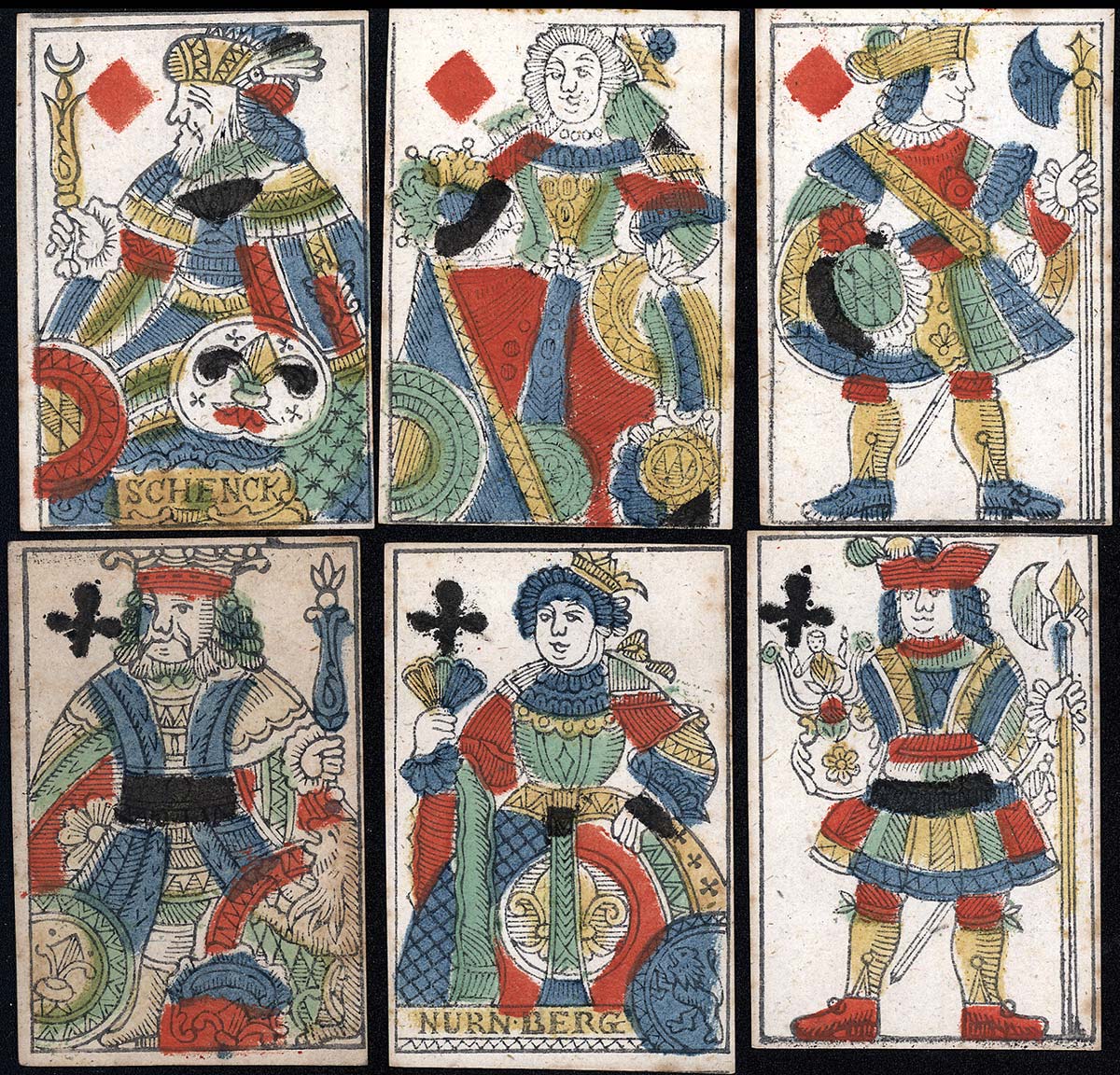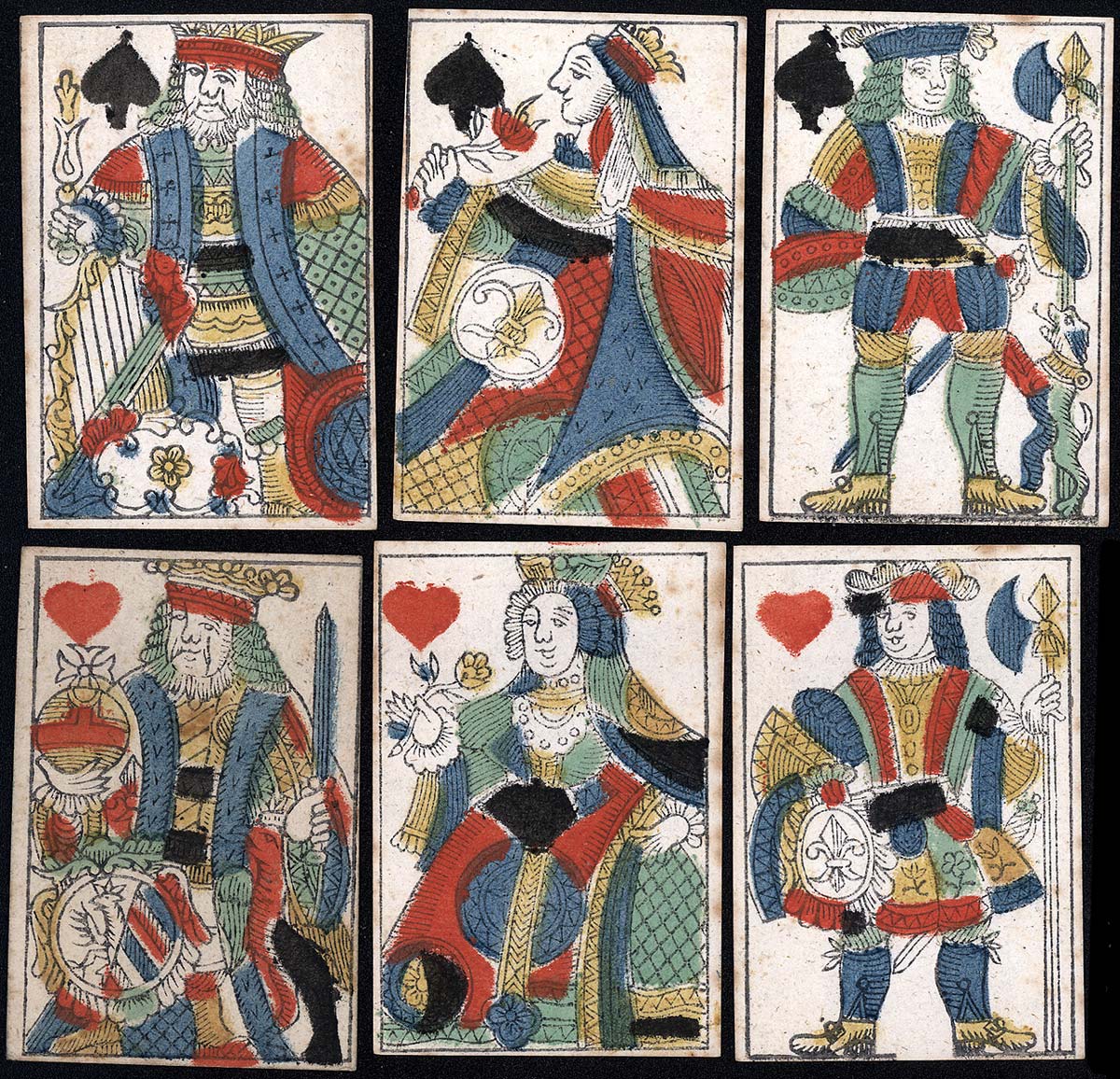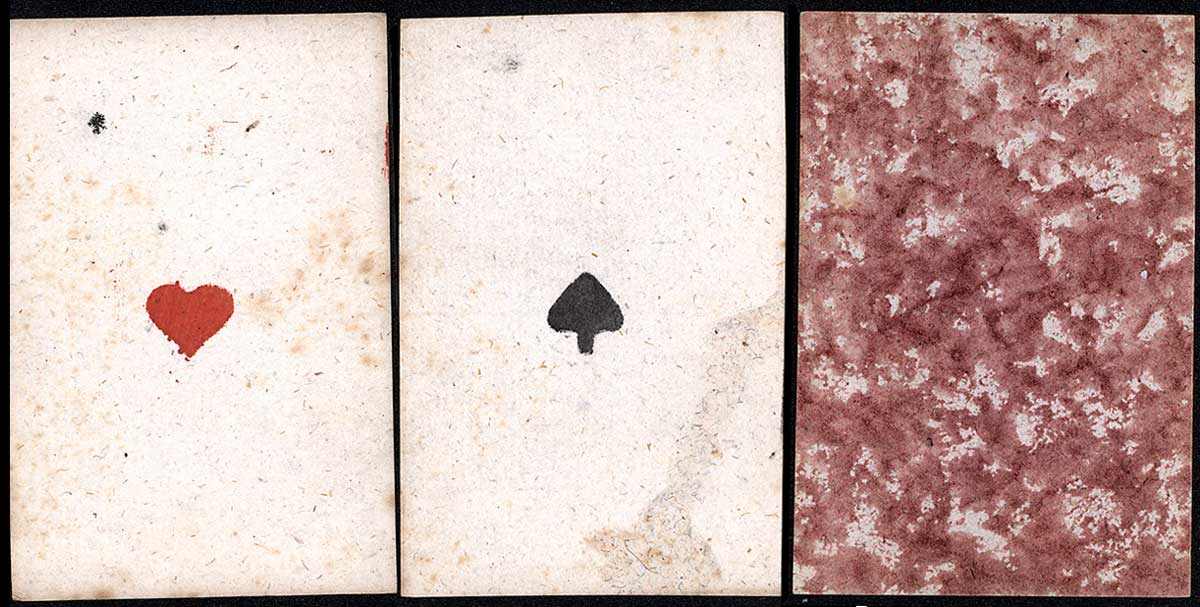I. Schenck, Nuremberg
I. Schenck, Nuremberg, late XVIIIth century
Playing cards printed from woodblocks by I. Schenck*, Nuremberg, late 18th century. The deck is a fine example of German standard cards derived from the Paris pattern but without the traditional names on the court cards. The cards are hand coloured with stencils in five colours but the black stencilling is a little messy in places. The king of diamonds has the maker’s name I. Schenck. Also, the jack of diamonds has a lettter ‘S’ on the halberd. The queen of clubs indicates the city where the cards were made, Nuremberg (German: Nürnberg), and the king of hearts features a Nuremberg coat-of-arms.
* There were three makers in Nürnberg that used “I. Schenck” on their cards, the father and his two sons. The father’s name was actually Johann Heinrich Schenck, but he sometimes used only the “I” on his cards. He is mentioned in Nürnberg as a journeyman in 1742 and 1751. Between 1755 and 1759 he became a master, and probably worked until 1787 when he died. The sons are Johann and Johannes, which may sound strange but is correct. Johannes became a master in 1772. He died in the same year as his father, 1787. Johann became a master in 1784, and died in 1839. The cards may have been made by any of them, but I guess that it was one of the sons. The cards were most probably made before 1800, as Johann Schenck produced similar double-headed cards later. Cards like these were first imported from France and then produced almost everywhere in Germany for local use. Notes courtesy Peter Endebrock.



Above: woodblock & stencil playing cards manufactured by I. Schenck, Nuremberg, late 18th century. The cards measure approximately 3” x 2” (78mm x 51mm), all with the same type of mottled back design. Images courtesy Steven & Marsha Goldblatt.

By Simon Wintle
Member since February 01, 1996
I am the founder of The World of Playing Cards (est. 1996), a website dedicated to the history, artistry and cultural significance of playing cards and tarot. Over the years I have researched various areas of the subject, acquired and traded collections and contributed as a committee member of the IPCS and graphics editor of The Playing-Card journal. Having lived in Chile, England, Wales, and now Spain, these experiences have shaped my work and passion for playing cards. Amongst my achievements is producing a limited-edition replica of a 17th-century English pack using woodblocks and stencils—a labour of love. Today, the World of Playing Cards is a global collaborative project, with my son Adam serving as the technical driving force behind its development. His innovative efforts have helped shape the site into the thriving hub it is today. You are warmly invited to become a contributor and share your enthusiasm.
Related Articles

Wiener Pattern – Nuremberg Version
A classic deck in a new illustrative style, with notable variations in line work, detail, and colour...

Luditz Pattern by Georg Geiselreiter
The discovery of 2024 changes the current state of knowledge of the history of this pattern.

CARD-AB Miltenberg
Illustrations by Rita Stern depicting notable landmarks and scenes from the town of Miltenberg in Ge...

New Altenburg Skat cards – German DDR Pattern
Authentic Altenburger Skat cards with German suits (Acorns, Hearts, Leaves, Bells).

German Travel Cards
A travel-themed educational deck helping American tourists visiting Germany.

French Revolutionary cards by Pinaut
Seven cards from a French Revolutionary pack by Pinaut featuring characters from classical antiquity...

Briefmarken-Quartett
Quartet game featuring postage stamps from the Zones of Occupation in post-WWII Germany.

IG Chemie Papier Keramik
Promotional pack designed by Karl-Heinz Schroers for a German trade union with comical bears on the ...

Engel-Tarot
Set of major arcana designed by Alois Hanslian depicting angels throughout.

Virgil Solis
Remarkable pack of 52 animal-suited playing-cards designed and etched by Virgil Solis.

Bertschinger y Codina - Cartes Françaises
French ‘Paris’ pattern made by Bertschinger y Codina, Barcelona, c.1850.

Politiker-Skat by Bubec
Caricatures of world leaders, including many German politicians, by the artist Bubec.

Le Poker Politique
French politicians and various world leaders caricatured by the German artist Bubec.

Rouen Pattern - Portrait Rouennais
An attractive XV century French-suited design from Rouen became the standard English & Anglo-America...

Redrawn French pattern (Héron)
Redrawn French pattern retaining traditional elements.

Unimog UX 100
Cartoons promoting the Unimog UX 100, a small truck produced by Mercedes-Benz.
Most Popular
Our top articles from the past 28 days

